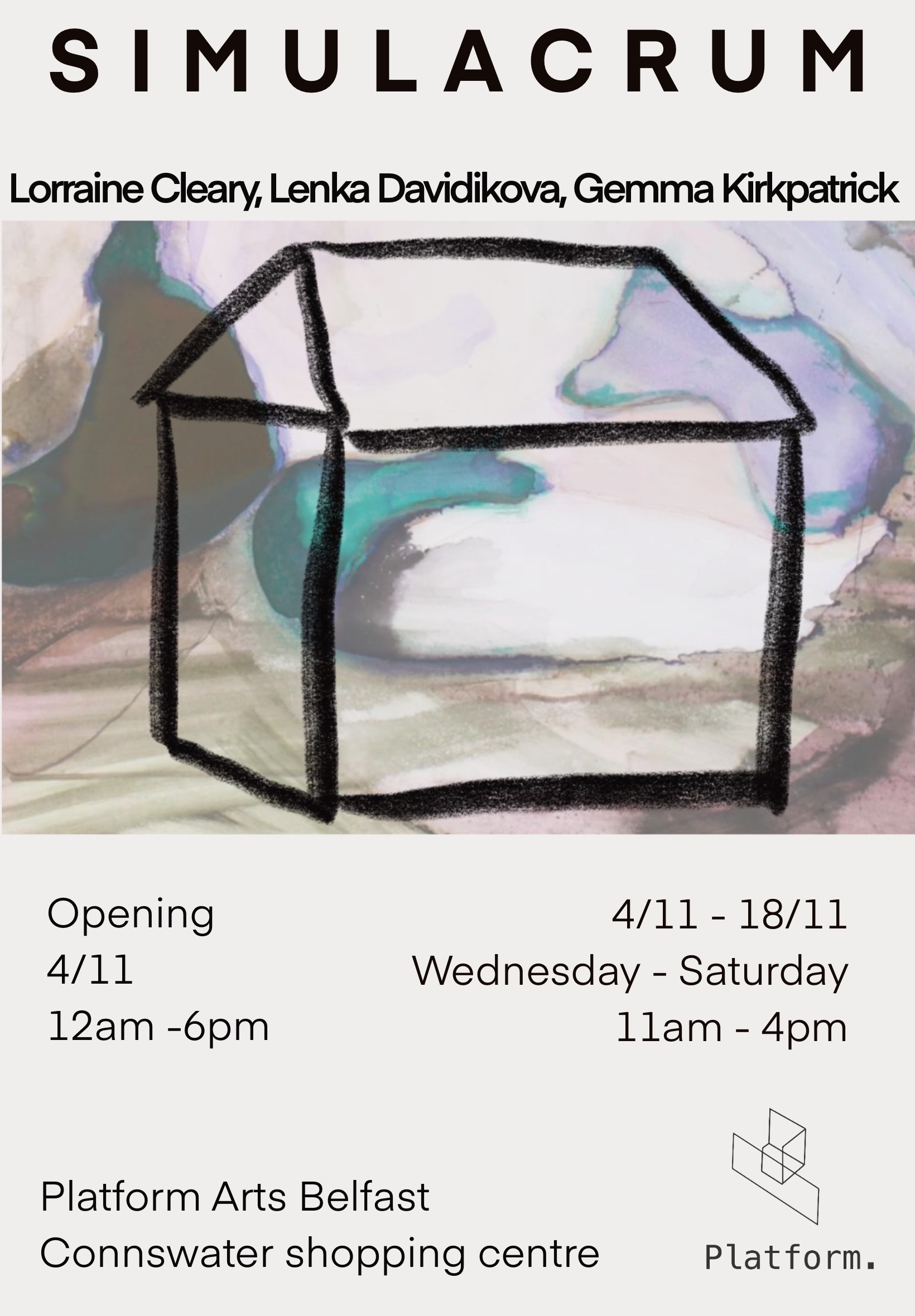
A group show by Lorraine Cleary, Lenka Davidikova and Gemma Kirkpatrick
Curated by Hannah McMurray
Opening Saturday 4th November 12am – 6pm
Gallery open Wednesday- Saturday 11 – 4pm
November 4th- November 18th
Simulacrum · noun · an unsatisfactory imitation or substitute – combines, in an exhibition of three female artists, Lorraine Cleary, Lenka Davidikova and Gemma Kirkpatrick.
These three artists were brought together as they all share, and explore themes of what it means to be a woman in various natural and more ambiguous settings. Being a woman is often defined by how you navigate spaces; be they domestic, societal, physical or metaphysical. This exhibition demonstrates how three female artists explore similar ideas and are taking very different approaches to their practices, and come together to ask how do we move through trauma? Exploring survival, with an emphasis on how women situate themselves within binding and oppressive settings. With a focus on how to reclaim female bodies, spaces and personal freedom for themselves.
Lorraine Cleary
Cleary’s practice embraces societal concerns and becomes a symbol of ‘the now’; it’s a visual response to the strength of the female as she navigates through a misogynistic culture. The concept behind the work derives from trauma and coercion associated with domestic abuse. Her work portrays a favourable aesthetic but behind that falsehood of perfection lies an insidious subtext. Despite being steeped in themes of injustice and oppression she tries to make work that is focused on the strength and endurance of women as they steer through impossible situations.
Cleary’s work attempts to create a thoughtful dialogue through careful re-fashioning of materials, a selective use of colour and a combination of light to draw the viewer into a disturbing domestic circumference. Cleary has advanced her practice by making textiles an integral part of the work combining it with reconstructed found objects and elements of light to communicate themes of oppression. Materials are an important aspect in her work and are carefully chosen for each piece. Cleary’s methodology involves working intuitively with materials; when an idea presents itself; she assembles materials into piles and assesses them to consider the possibilities. Once she begins working in earnest with the materials that idea becomes more concrete, then a title comes to mind, at which point the rest of the materials are sourced to complete the work, problem solving as she goes.
Colombian artist Doris Salcedo is among the artists that inspire Cleary. Salcedo’s work gives form to pain, fear, trauma and loss; she produces handcrafted sculptures and site-specific installations that encourage individual and collective mourning. Another inspiration is Russian film director Andrei Tarkovsky who had the ability to see beauty in the everyday, he had a unique understanding of time and through single point perspective he mimicked a likeness of the real world on screen. Philosopher Henri Bergson’s research into how the past, present and future collide, has been a constant source of inspiration to Cleary. Bergson used the term “virtual” in the ontological sense to denote temporal
qualities in relation to the movement of time.
Cleary is motivated by her own experience with Domestic abuse, after spending years in an abusive marriage. Cleary makes work that adapts to the gallery space, and by viewing it in correlation with the space of the home she brings the private out into the public in a move to open up a discourse around the hidden injustices of the female within the home. Victims of domestic abuse can find themselves isolated and subjected to persistent rituals of cruelty, which ultimately leads to fragile emotional states. Those that find themselves in this situation question their own sanity and develop low self-esteem. Fear and anxiety are disorders that arise as a result of abuse. Victims of abuse can develop CPTSD, symptoms of which include flashbacks, nightmares and anxiety.
Lenka Davidikova
Lenka Davidikova was born in 1980 in Dolny Kubin, Czechoslovakia. In 2006 Davidikova moved to Belfast, Northern Ireland. In 2012 she successfully graduated in Fine Art from the University of Ulster and she has been a practicing artist working from her studio since then.
Lenka Davidikova’s artwork explores the idea of searching for an interpretation of the human condition, through introspection, and relationships with others. There is a sense of attraction to alienated, displaced characters in her artwork. Davidikova does not aim to create fixed images, guided by concentrated, focused attention; rather, she aims to be guided by active but unfocused attention, resulting in correspondences guided by ‘unconscious scanning’. Her artistic practice consists mainly in working with various drawing media or ink. It is the immediate action these media offer that she is drawn to. The versatile ability of charcoal and graphite allows her to capture both gestures and emotions. In contrast, the limitations of the usage of ink, place a demanding element upon the artist’s fluid fixations.
Recently Davidikova started to experiment with the idea of making hand sewn 3D textile sculptures representing the human form which is often crippled. Having studied Fashion Design in Slovakia and hand sewing from a very early age, going back to reinterpreting skills and motions she once enjoyed becomes an important fresh element to her artwork.
Gemma Kirkpatrick
Gemma Kirkpatrick graduated from the MFA programme at Belfast School of Art (2020) having previously graduated from the BA Hons Fine Art (Painting) in 2017, receiving the Dean’s List Award. Her work has been included in a number of group exhibitions across Northern Ireland and has been previously shortlisted for the Open Contemporary Young Artist Award at the Biscuit Factory Gallery, Newcastle Upon Tyne (2019) as well as the RDS Visual Arts Award (2020). She is currently a member of Arcade Studios, Belfast.
